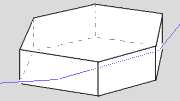|
 |
A 7° high sun flanked by bright parhelia.
Sundogs (parhelia, mock suns) are, with the 22º halo, the most
frequent of the halos. Look for them, especially when the sun is low,
at each side and about 22° away. This is the same distance or
more** than
the common circular halo.
Sundogs reveal that the clouds are hosting horizontal plate crystals.
These plates drift slowly downwards like leaves with their large faces
almost horizontal.
Sundogs are formed when light passes through crystal side faces
inclined at 60° to each other. The rays, like those of
the 22° halo, are deviated by up to
50° but those near to the minimum deviation condition of near** to 22° are
the most numerous and they form the very bright sundog inner edges.
Sundogs are often brightly coloured because the crystals refract each
colour by a different amount.
|
| |
In
the simulation a parhelic circle and
a sun pillar, also produced by plate
crystals, are visible. Some poorly oriented crystals produced the
22° reference halo. Sundogs often curve upwards in photographs and
simulations, this is a projection effect and they are always at the
same altitude as the sun.
** Unlike the 22° circular halo, sundogs are not
always 22° from the sun. As the sun gets higher
they pull away from the 22° halo because the rays forming them
become increasingly skewed relative to the crystal axis. Take a look at
Tom Eklund's image
when the sun was 43º high. |
|
|
|
